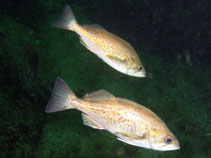| Family: |
Sebastidae (Rockfishes, rockcods and thornyheads), subfamily: Sebastinae |
| Max. size: |
60 cm TL (male/unsexed); max. reported age: 60 years |
| Environment: |
pelagic-neritic; marine; depth range 0 - 549 m |
| Distribution: |
Northeast Pacific: middle Albatross Bank in the Gulf of Alaska to Todos Santos Bay, Baja California, Mexico. |
| Diagnosis: |
Dorsal spines (total): 13-13; Dorsal soft rays (total): 14-16; Anal spines: 3-3; Anal soft rays: 8-10. Head spines weak - nasal, preocular spines present, parietals usually present, supraocular, postocular and tympanic spines usually absent, coronal and nuchal spines absent (Ref. 27437). Interorbital space convex, sloped; no symphyseal knob; caudal peduncle narrow; anal fin with a strong posterior slant (Ref. 27437). Caudal fin indented (Ref. 6885). Gold brown to dusky, light ventrally; membranes of fins dark, lighter on spinous dorsal (Ref. 27437). |
| Biology: |
A generally active and free-swimming rockfish found in midwater above a rocky reef or steep shoreline; occasionally huddling motionless among caves and crevices (Ref. 27436). Young are found in shallow water (Ref. 2850). Form schools (Ref. 2850). Feed mostly on small pelagic crustaceans and fishes (Ref. 2850). Viviparous (Ref. 34817). Marketed fresh and frozen; eaten pan-fried, boiled, microwaved and baked (Ref. 9988). |
| IUCN Red List Status: |
Not Evaluated (N.E.) Ref. (130435)
|
| Threat to humans: |
harmless |
Source and more info: www.fishbase.org. For personal, classroom, and other internal use only. Not for publication.
